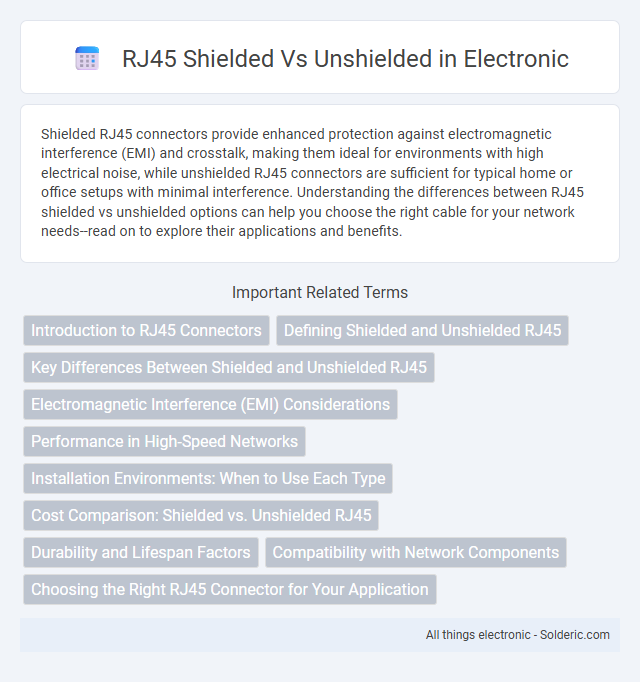Shielded RJ45 connectors provide enhanced protection against electromagnetic interference (EMI) and crosstalk, making them ideal for environments with high electrical noise, while unshielded RJ45 connectors are sufficient for typical home or office setups with minimal interference. Understanding the differences between RJ45 shielded vs unshielded options can help you choose the right cable for your network needs--read on to explore their applications and benefits.
Comparison Table
| Feature | RJ45 Shielded (STP) | RJ45 Unshielded (UTP) |
|---|---|---|
| Shielding | Metal shielding around pairs and connector | No shielding, twisted pairs only |
| Interference Protection | High - protects against EMI and crosstalk | Low - susceptible to EMI and crosstalk |
| Use Case | Industrial, high EMI environments, data centers | Office, home networks, low EMI environments |
| Cost | Higher due to shielding materials | Lower, more affordable |
| Installation | Requires grounding and careful handling | Easy and quick installation |
| Performance | More stable data transmission in noisy environments | Good performance in low interference conditions |
Introduction to RJ45 Connectors
RJ45 connectors serve as standard interfaces for Ethernet networking cables, with shielded (STP) and unshielded (UTP) versions designed to enhance signal integrity in different environments. Shielded RJ45 connectors provide protection against electromagnetic interference (EMI) and crosstalk, making them ideal for industrial or high-EMI settings. Your choice between shielded and unshielded should consider factors like cable installation location, interference levels, and network speed requirements to ensure optimal connectivity.
Defining Shielded and Unshielded RJ45
Shielded RJ45 connectors include a protective metal casing that reduces electromagnetic interference (EMI) and crosstalk, enhancing signal integrity in high-noise environments. Unshielded RJ45 connectors lack this metal shielding, making them more suitable for typical office or home networking where interference is minimal. Your choice between shielded and unshielded RJ45 depends on the level of environmental interference and network performance requirements.
Key Differences Between Shielded and Unshielded RJ45
Shielded RJ45 connectors include a metal shield that protects against electromagnetic interference (EMI) and crosstalk, making them ideal for environments with high electrical noise. Unshielded RJ45 connectors lack this metal shielding, providing a cost-effective solution for typical home or office networks with minimal interference. Choosing the right type ensures your network maintains optimal performance and data integrity based on your specific environmental needs.
Electromagnetic Interference (EMI) Considerations
Shielded RJ45 cables (STP) are designed with a metallic foil or braided shielding that significantly reduces electromagnetic interference (EMI), making them ideal for environments with high electrical noise such as industrial settings or near heavy machinery. Unshielded RJ45 cables (UTP) lack this protective layer, which makes them more susceptible to EMI, potentially causing data transmission errors and reduced network performance in electrically noisy environments. Choosing shielded cables enhances signal integrity and reduces crosstalk, especially in installations with multiple cable runs in close proximity to EMI sources.
Performance in High-Speed Networks
Shielded RJ45 cables significantly reduce electromagnetic interference (EMI), making them ideal for maintaining signal integrity in high-speed network environments exceeding 1 Gbps. Unshielded RJ45 cables, while more cost-effective, may suffer from crosstalk and noise in areas with heavy electrical interference, potentially degrading your network performance. Choosing shielded connectors ensures consistent data transmission and minimizes packet loss in demanding high-bandwidth applications.
Installation Environments: When to Use Each Type
RJ45 shielded cables are ideal for installation environments with high electromagnetic interference (EMI), such as industrial settings, data centers, or near heavy machinery, as their shielding reduces signal noise and maintains data integrity. Unshielded RJ45 cables are suitable for standard office or residential environments with minimal interference, offering easier installation and flexibility at a lower cost. Choosing the correct cable type based on the presence of EMI ensures optimal network performance and reduces the risk of data transmission errors.
Cost Comparison: Shielded vs. Unshielded RJ45
Shielded RJ45 cables typically cost 20-50% more than unshielded variants due to their protective metal layer that reduces electromagnetic interference (EMI). Unshielded cables are more budget-friendly and suitable for environments with minimal electrical noise, making them ideal for basic residential or office setups. Investing in shielded RJ45 cables proves cost-effective in industrial or high-interference zones by preventing data loss and network downtime, which can incur higher expenses over time.
Durability and Lifespan Factors
RJ45 shielded cables feature a protective metal foil or braided mesh that significantly enhances durability by preventing electromagnetic interference (EMI) and physical damage, extending the cable's lifespan in harsh environments. Unshielded RJ45 cables lack this protective layer, making them more susceptible to signal interference and wear over time, which can reduce operational longevity. Environmental factors such as exposure to moisture, mechanical stress, and electromagnetic interference influence the lifespan of both shielded and unshielded RJ45 cables, with shielded variants generally offering superior resistance and sustained performance.
Compatibility with Network Components
RJ45 shielded cables provide enhanced protection against electromagnetic interference, making them ideal for environments with high electrical noise and ensuring reliable data transmission with compatible shielded switches and routers. Unshielded RJ45 cables offer flexibility and cost-effectiveness but may experience signal degradation in electrically noisy settings, best suited for standard network components without shielding requirements. Choosing the correct cable type ensures your network components maintain optimal performance and connectivity.
Choosing the Right RJ45 Connector for Your Application
Selecting the appropriate RJ45 connector depends on your environment's electromagnetic interference (EMI) levels and cable type. Shielded RJ45 connectors are ideal for industrial or high-EMI areas, providing enhanced protection through grounding and metal housing to reduce signal degradation. Unshielded connectors suit typical office or home networks where EMI is minimal, offering cost-effectiveness and easier installation.
RJ45 shielded vs Unshielded Infographic

 solderic.com
solderic.com